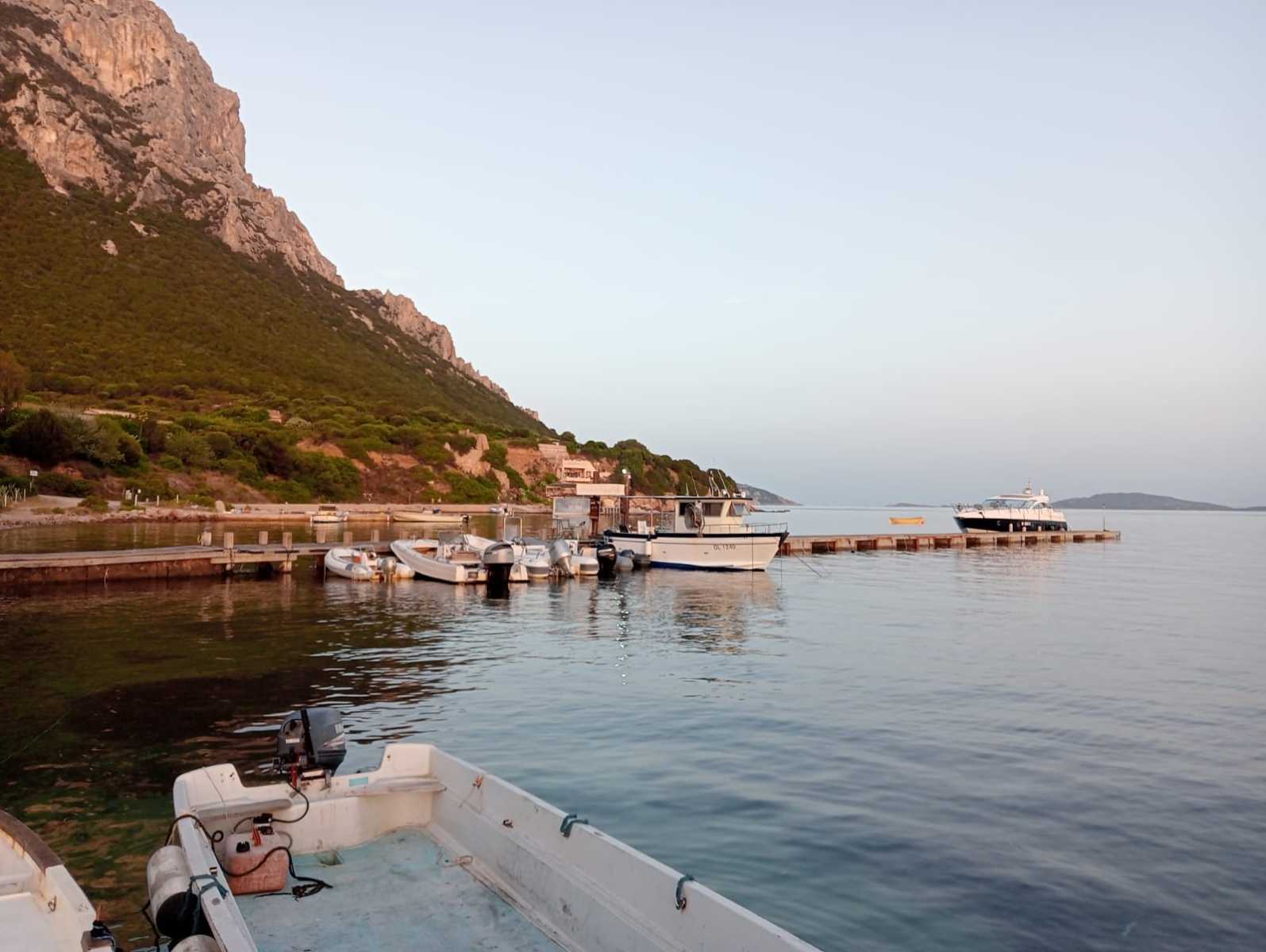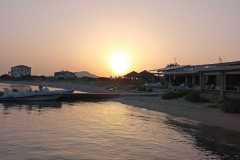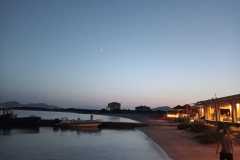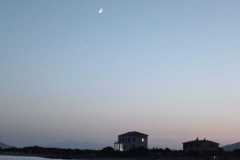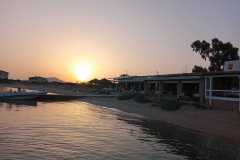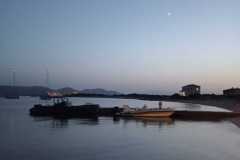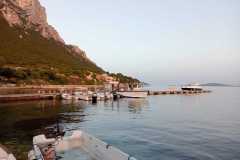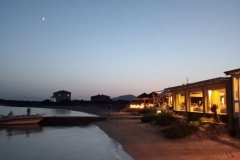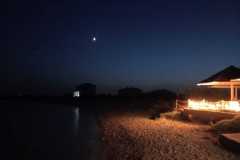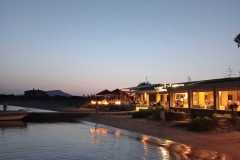Tavolara è un’isola di 5,9 km² della Sardegna nord-orientale, parte del comune di Olbia, in Provincia di Sassari, nella subregione della Gallura.
Ricca di storia e leggende antiche e moderne, quest’isola dalla singolarissima conformazione si propone sulla scena della mitologia classica per rappresentare la nave dei Feaci pietrificata da Poseidone, col suo timone rivolto verso il mare aperto, rea di avere ricondotto Ulisse in patria.
L’isola si presenta come un maestoso massiccio calcareo a picco sul mare, di forma grossomodo rettangolare, lungo circa 6 km e largo 1 km; poggia su un substrato roccioso granitico che emerge chiaramente in alcune parti; raggiunge una quota massima di 565 metri s.l.m. e alle estremità presenta due capi più facilmente accessibili. Il capo sul lato ovest dell’isola (Spalmatore di Terra) è rivolto verso Loiri Porto San Paolo e accoglie gli scarsi insediamenti civili sull’isola e le più belle spiagge. Vi sono stati ricavati anche degli approdi per piccole imbarcazioni, che collegano l’isola con il porto di Loiri Porto San Paolo. Il capo sul lato est, rivolto verso il mar Tirreno, è costituito dalla punta Timone, che divide due piccole baie (rispettivamente esposte a NW e SE). Ospita, oltre ad un faro di segnalazione marittima, una base militare NATO, gestita dalla Marina Militare, destinata alle telecomunicazioni terrestri a lunghissimo raggio e bassissima frequenza. Le relative tre antenne, alte più di duecento metri, sono facilmente visibili anche a distanza. Nei pressi di Punta del Papa si osserva un maestoso arco naturale sopra il quale si trovano i ruderi del vecchio faro, abbandonato perché costruito troppo in alto e spesso occultato dalla coltre di nuvole. L’isola è attraversata da una piccola strada militare, con ampi tratti in galleria, che collega la base militare ad un molo di approdo sul lato ovest dell’isola, utilizzato quando le condizioni meteomarine rendono difficile l’approdo nel porticciolo annesso alla base militare.
Quest’isola selvaggia e incontaminata fa parte dell’Area Marina Protetta di Tavolara e Capo Coda Cavallo e offre fondali incontaminati e riparo per la nidificazione di numerose specie di uccelli marini. Tra questi, unica al mondo per importanza quantitativa la popolazione di berta minore (Puffinus yelkouan, nome locale “tampesca”): Tavolara ospita più di metà della popolazione mondiale di questa specie. Di abitudini notturne, questo uccello marino nidifica ogni anno, a partire da marzo, entro tane sotterranee dal livello del mare fino alle più alte quote, e abbandona la zona in estate per spostarsi verso l’Egeo e il Mar Nero. Però gran parte delle uova deposte a Tavolara vengono predate dai ratti, sui quali sono in corso progetti di contenimento.
La leggenda del “regno di Tavolara”
In epoca antica, sull’isola furono esercitati i diritti feudali goduti dall’omonima famiglia Tavolara, la quale successivamente abbandonò il possesso dell’isola a causa della posizione e delle difficoltà connesse al suo utilizzo.
Sul finire del Settecento, Giuseppe Bertoleoni (di origine corso-genovese) giunse in prossimità dell’arcipelago di La Maddalena, costeggiando la Corsica, a bordo di una piccola nave da diporto proveniente da Genova, in cerca di una terra in cui abitare; si stabilì dapprima sull’isolotto di Spargi, poi si spostò più a sud, sulla piccola isola di Mortorio, ma, spinto dalla ricerca di un’isola più generosa e ospitale, navigando ancora verso sud, raggiunse nel 1806 l’isola disabitata di Tavolara. Qui si stabilì con la famiglia, dedicandosi all’allevamento delle capre selvatiche, assai numerose sul territorio e caratterizzate da una particolare colorazione dorata della dentatura, causata dall’alimentazione.
Nel 1836 il re di Sardegna Carlo Alberto di Savoia, di passaggio per quei luoghi (si stava recando a caccia), notò l’isoletta sconosciuta: chiese pertanto informazioni ai suoi marinai, ma, non ottenendo risposte sufficienti, decise di approdarvi. Presentatosi ai residenti come il re di Sardegna, sembra che Giuseppe Bertoleoni, circondato dalle capre dai denti dorati, forse convinto che colui che aveva di fronte gli stesse giocando uno scherzo, abbia risposto: “E io sono il re di Tavolara!”.

Carlo Alberto avrebbe soggiornato presso di lui per una settimana e, congedandosi, gli diede in dono un orologio d’oro e – secondo i Bertoleoni – diede il consenso a riconoscere l’indipendenza di Tavolara: non molto tempo dopo risulterebbe essere arrivata, infatti, alla prefettura di Sassari, una pergamena reale, firmata dal re, in cui Giuseppe e i suoi eredi venivano infeudati – non, quindi, riconosciuti come Stato sovrano – di Tavolara. Di ciò, tuttavia, resta la sola testimonianza verbale della famiglia, in quanto la casata Bertoleoni non figura negli elenchi nobiliari ufficiali del Regno d’Italia. Di conseguenza la sua nobiltà non risulta legalmente riconosciuta nel periodo monarchico.

Nel frattempo a Giuseppe Bertoleoni “succedette” il figlio Paolo, detto Polo, che si proclamò “re” col nome di Paolo I, sposò una donna sarda, Pasqua Favale, e da lei ebbe il figlio Carlo (I). A detta di quest’ultimo, l’isola fu visitata nel 1896 da inviati della regina Vittoria del Regno Unito, a bordo nella nave “Vulcan”, che avrebbe tacitamente riconosciuto l’esistenza del minuscolo “regno”. In una fotografia in cui al centro appare Carlo I circondato da parenti collaterali, scattata sul ponte della nave, si può notare la scritta “Vulcan” sulla cintura della giovane in primo piano. I Bertoleoni narrano che in una sala di Buckingham Palace, a Londra, sia conservata la foto della “famiglia reale” di Tavolara, all’interno della collezione di ritratti delle dinastie regnanti di tutta la terra, con la dicitura: «La famiglia reale di Tavolara, nel golfo di Terranova Pausania, il più piccolo regno del mondo». “Di fatto”, l’isola entrò a far parte del territorio del Regno d’Italia, all’atto della proclamazione di quest’ultimo, il 17 marzo 1861.
Va infine osservato che ai Bertoleoni appartengono solo alcune piccole case nello spalmatore di terra e due ristoranti autorizzati con licenza dal comune di Olbia, mentre il resto dell’isola è stato concesso dall’Italia alla NATO come servitù militare o è di proprietà della famiglia veneto-romana dei Marzano.
I Bertoleoni sono sepolti a Tavolara nel piccolo cimitero di Spalmatore di Terra, dove riposa anche lo storico Girolamo Sotgiu.
L’ultimo discendente della famiglia, Tonino Bertoleoni, si attribuisce il titolo di re di Tavolara.
English Version
Tavolara is a 5.9 km² island in northeastern Sardinia, part of the municipality of Olbia, in the Province of Sassari, within the subregion of Gallura.
Rich in history and legends, both ancient and modern, this island with its very unique shape features in classical mythology as the ship of the Phaeacians turned to stone by Poseidon, with its rudder pointing towards the open sea, punished for having brought Odysseus back home.
The island is a majestic limestone massif that rises sharply from the sea, roughly rectangular in shape, about 6 km long and 1 km wide. It rests on a granitic rocky substrate that is clearly visible in some parts. It reaches a maximum elevation of 565 meters above sea level and has two more easily accessible headlands at its extremities. The headland on the west side of the island (Spalmatore di Terra) faces Loiri Porto San Paolo and hosts the few civil settlements on the island and the most beautiful beaches. There are also docks for small boats, connecting the island with the port of Loiri Porto San Paolo. The headland on the east side, facing the Tyrrhenian Sea, is called Punta Timone, dividing two small bays (facing NW and SE respectively). It houses, in addition to a maritime signaling lighthouse, a NATO military base managed by the Italian Navy, intended for very long-range and very low-frequency terrestrial telecommunications. The related three antennas, over two hundred meters high, are easily visible even from a distance. Near Punta del Papa, a majestic natural arch can be seen, above which are the ruins of the old lighthouse, abandoned because it was built too high and often hidden by clouds. The island is crossed by a small military road, with long stretches in tunnels, that connects the military base to a landing dock on the west side of the island, used when sea weather conditions make it difficult to dock at the port attached to the military base.
This wild and unspoiled island is part of the Marine Protected Area of Tavolara and Capo Coda Cavallo and offers pristine seabeds and shelter for the nesting of numerous species of seabirds. Among these, the population of the Yelkouan shearwater (Puffinus yelkouan, locally known as “tampesca”) is unique in the world for its quantitative importance: Tavolara hosts more than half of the world population of this species. Nocturnal by habit, this seabird nests annually from March in underground burrows from sea level up to the highest elevations, and leaves the area in summer to move towards the Aegean and the Black Sea. However, many of the eggs laid on Tavolara are preyed upon by rats, on which containment projects are ongoing.
The Legend of the “Kingdom of Tavolara”
In ancient times, feudal rights were exercised on the island by the Tavolara family, who later abandoned the possession of the island due to its location and the difficulties associated with its use.
At the end of the 18th century, Giuseppe Bertoleoni (of Corsican-Genoese origin) arrived near the La Maddalena archipelago, coasting Corsica on a small pleasure boat from Genoa, in search of a place to live. He first settled on the islet of Spargi, then moved further south to the small island of Mortorio, but, driven by the search for a more generous and hospitable island, he sailed further south and reached the uninhabited island of Tavolara in 1806. Here he settled with his family, dedicating himself to the breeding of wild goats, which were very numerous on the territory and characterized by a particular golden coloration of their teeth, caused by their diet.
In 1836, the King of Sardinia, Carlo Alberto di Savoia, passing through those places (he was on a hunting trip), noticed the unknown islet: he asked his sailors for information, but, not receiving sufficient answers, decided to land there. Introducing himself to the residents as the King of Sardinia, it is said that Giuseppe Bertoleoni, surrounded by the golden-toothed goats, perhaps convinced that the person in front of him was playing a joke, responded: “And I am the King of Tavolara!”
Carlo Alberto is said to have stayed with him for a week, and upon leaving, gave him a gold watch and – according to the Bertoleoni – gave his consent to recognize the independence of Tavolara: not long after, a royal parchment signed by the king reportedly arrived at the prefecture of Sassari, enfeoffing Giuseppe and his heirs – not, therefore, recognizing them as a sovereign state – of Tavolara. However, this remains only the verbal testimony of the family, as the Bertoleoni lineage does not appear in the official noble lists of the Kingdom of Italy. Consequently, their nobility is not legally recognized during the monarchical period.
Meanwhile, Giuseppe Bertoleoni was “succeeded” by his son Paolo, known as Polo, who proclaimed himself “king” with the name of Paolo I, married a Sardinian woman, Pasqua Favale, and had a son, Carlo (I). According to the latter, the island was visited in 1896 by envoys of Queen Victoria of the United Kingdom, aboard the ship “Vulcan,” which tacitly recognized the existence of the tiny “kingdom.” In a photograph with Carlo I at the center surrounded by collateral relatives, taken on the deck of the ship, one can see the word “Vulcan” on the belt of the young woman in the foreground. The Bertoleoni claim that in a room at Buckingham Palace in London, there is a photo of the “royal family” of Tavolara, within the collection of portraits of the reigning dynasties of the world, with the inscription: “The royal family of Tavolara, in the Gulf of Terranova Pausania, the smallest kingdom in the world.” “In fact,” the island became part of the territory of the Kingdom of Italy, upon its proclamation on March 17, 1861.
Finally, it should be noted that the Bertoleoni own only a few small houses in Spalmatore di Terra and two restaurants authorized with a license from the municipality of Olbia, while the rest of the island has been granted by Italy to NATO as a military easement or is owned by the Venetian-Roman family of the Marzano.
The Bertoleoni are buried in Tavolara in the small cemetery of Spalmatore di Terra, where the historian Girolamo Sotgiu also rests.
The last descendant of the family, Tonino Bertoleoni, claims the title of King of Tavolara.
